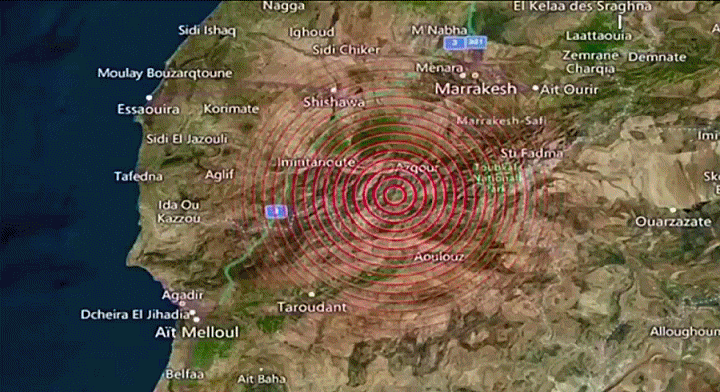DEADLY EARTHQUAKE IN MOROCCOMORE THAN 2900 DEATHS | |
Tremors felt across Morocco The earth shook in central Morocco, in the region of Marrakech, at a magnitude of 7 on the Richter scale, on the night of Friday 8 to Saturday 9 September. The epicenter of this earthquake is located southwest of the tourist city of Marrakech, 320 km south of the capital Rabat, according to the American Institute of Geophysics (USGS). The number of victims is constantly increasing, significant damage is reported. The latest report from the Moroccan authorities shows 2,862 deaths, according to the latest report from the Ministry of the Interior. Relief diplomacy Catherine Colonna, the Minister of Foreign Affairs, announced on Monday aid of 5 million euros to support NGOs, French or others, already on site. She especially denounced the "bad controversy" emerging after Morocco's choice to accept aid offered by four States (Spain, United Kingdom, Qatar, United Arab Emirates), but not that of France, nor others countries that have reached out. Some see it as a snub inflicted on France for its very tense relations with Morocco, around questions of migration, freedom of speech, Western Sahara and Algeria. However, the kingdom has not officially refused any aid, present or future, from France, and the choice of countries called as a priority is intended to be dictated by pragmatism. “For example, Qatar has the best dogs, the United Kingdom the best drones,” explains Abdelmalek Alaoui, president of the Moroccan Institute of Strategic Intelligence (Imis), in Rabat. In fact, significant resources are being mobilized to come to the aid, particularly isolated villages in the High Atlas. Because few villages were spared by the earthquake around Moulay Brahim and Taloudennt. The villages of Asni and Ouiargane are almost completely destroyed. Traditional houses, built of stone and clay, are particularly vulnerable. Significant resources have been mobilized in these mountains to help the victims. The inhabitants had to, at first, fend for themselves, due to a lack of a passable road, then, during the night, the emergency services were finally able to access the affected area. Ouarzazate, Azilal, Chichaoua and Taroudant are the towns most most affected in the province, but the earthquake was felt as far away as Casablanca and Rabat. Royal gendarmerie helicopters were sent to the most isolated villages. Moroccan rescuers, supported by foreign teams, are trying to speed up searches to find possible survivors and provide shelter to hundreds of families who have lost their homes. The Moroccan Ministry of National Education announced on Monday that 530 schools and 55 boarding schools were damaged. Seven teachers died and 39 others were injured, the minister also announced in a press release published on Instagram. Classes were suspended in 42 localities, including the provinces of Chichaoua, Taroudant and Al Haouz. This earthquake is the strongest ever measured in Morocco, and the deadliest since the one that destroyed Agadir, on the west coast of the country, in 1960, causing nearly 15,000 victims. |
|
| Carl Delsey for DayNewsWorld | |
 |
|




 F
F